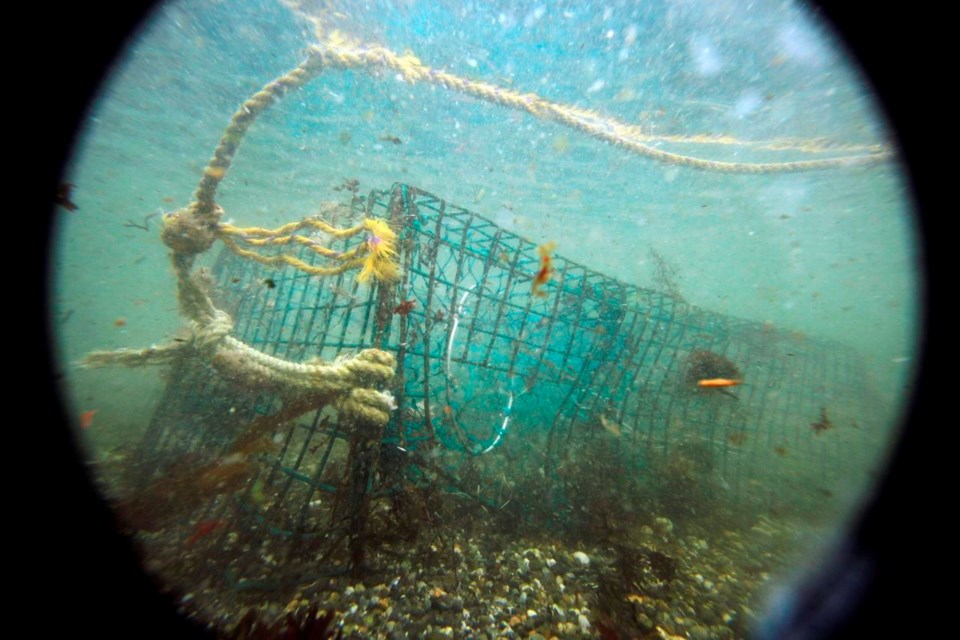HALIFAX — A study published Wednesday details the economic and environmental effects caused by tonnes of lost and discarded fishing gear in some of Canada’s most lucrative fishing grounds.
A team of Dalhousie University scientists worked with fishing captains, conservation groups, volunteers and the federal Fisheries Department, which funded the study, to retrieve 25,000 kilograms of so-called ghost gear from three fishing zones off southwestern Nova Scotia.
Boats towing grapples covered a 4,000-square-kilometre area of sea floor off the Atlantic coast around to the Bay of Fundy — a region noted for its rich cache of lobster and other marine species. The project ran from 2019 to 2021, recovering traps, ropes, hooks, cables and other fishing-related equipment.
Tony Walker, an associate professor in Dalhousie’s school for resource and environmental studies, said the study shows that the problems caused by ghost gear such as lobster traps are pervasive.
"People should understand it’s not just lost to the bottom and then we can forget about it and no harm done,” said Walker. “These traps continue to catch fish."
The study, published in Marine Pollution Bulletin, points out that according to the Fishing Gear Coalition of Atlantic Canada, gear loss in trap fisheries is estimated at between 0.5 and two per cent of total allowable traps.
It says that within the selected retrieval areas, nine fish species listed as at risk are potential bycatch: American plaice, Atlantic cod, Atlantic wolffish, cusk, lumpfish, Northern wolffish, spiny dogfish, spotted wolffish and white hake. The gear could also harm other species at risk, such as migratory species and marine mammals, the study says.
Walker said researchers documented 25 different species caught in the lost traps, including 652 individual lobster, of which 82 per cent were market size. Fifty-seven fish were also found with 42 of those belonging to species at risk.
“So it’s not just a problem for the lobster, it's a problem for the industry and it’s also a problem for marine conservation,” Walker said.
The research project found another 5,000 kilograms of assorted fishing gear during shoreline searches. Overall, lobster traps made up 68 per cent of the gear recovered and dragger cable accounted for 12 per cent. The cost of the lost gear to the local fishing industry is estimated at $240,000 per year.
A total of 997 grappling tows were completed over the course of the study with about two-thirds coming up empty.
In the case of lobster traps that were retrieved, the study found those with tags ranged in age from one to 37 years old. About 30 per cent were one-year-old, and approximately one-third of the recovered traps were still usable.
Meanwhile, the study noted that some of the buoys retrieved in the Pubnico, N.S., and Yarmouth, N.S., areas originated from the United States “highlighting the multijurisdictional nature of marine debris, and ghost gear more specifically.”
Walker said the grappling technique improved during the course of the study to a point where if there is suitable funding it could make a difference in gear retrieval efforts.
“Our success rate improved over time so we know those lessons learned can be transferred to other community groups in other areas of Nova Scotia and across Canada,” he said.
Walker said a policy change is also needed to allow fishers who find gear to bring it ashore for reuse or disposal, without fear of losing their licences for suspected poaching of others' gear.
“There are some policy barriers that can be loosened,” he said. “We could also have continued funding … so community groups and fishers have all the tools available to remove this stuff.”
This report by The Canadian Press was first published May 10, 2023.
Keith Doucette, The Canadian Press



